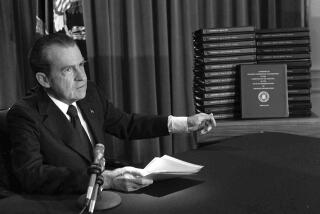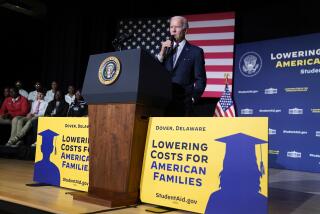Average Americans are feeling pain of U.S. debt
WASHINGTON — When it comes to the nation’s debt, payback time might be here.
Years of low tax rates and rising federal spending, amplified by the devastating economic effect of the Great Recession, have driven the U.S. borrowing tab to more than $16 trillion from less than $1 trillion in 1981.
Deficit reduction has become the dominant issue in Washington. The first major tax increase since 1993 took place last month. And large automatic spending cuts — $1.2 trillion over the next decade — are set to kick in Friday.
The result: Average Americans are starting to feel the pain.
“The day of reckoning is here,” said David Walker, the former U.S. comptroller general who has been warning about the nation’s long-term fiscal problems for several years.
“We’re at the end of an era where we have Democratic spending policies and Republican tax policies,” he said. “The result has been huge deficits and mounting debt burdens. It doesn’t work.”
QUIZ: Do you know about the looming cuts?
In attempts to solve the problem, Republicans have focused on reducing government spending. Democrats have aimed at increasing taxes on the wealthy. And both parties leveraged their influence over the last two years to get their way.
When the nation approached its statutory borrowing limit in 2011, Republicans in Congress insisted on large spending cuts before agreeing to raise the cap. The last-minute deal to avoid a default included caps on future spending and a mechanism for automatic cuts this year if lawmakers could not agree on an alternative.
So far, they have not been able to get close to a deal. And time is running out.
On top of that, the George W. Bush-era tax cuts were set to expire at the end of 2012, along with a two-year payroll tax break designed to stimulate the economy. To help reduce the deficit, President Obama pushed Congress to allow some of those tax cuts to expire.
The face-off risked market panic and another recession, and ultimately Republicans agreed to allow some taxes to rise.
The result has been a double whammy of higher taxes and reduced government spending that would stabilize the debt as a set percentage of the U.S. economy over the next decade, even as it gives Americans their first taste of austerity.
Although the Jan. 2 tax increases focused on rates for household incomes of more than $450,000, they also included the end to a temporary payroll tax break that reduced the average person’s paycheck about $40 every two weeks.
In addition, government officials said the looming spending cuts would affect most federal programs. The effect would be widespread, hitting state and local programs that depend on federal aid and businesses with government contracts.
But some would directly affect the general public, with the furloughing of government workers leading to fewer food safety inspections, reduced hours at national parks and longer waits at airports.
For example, Transportation Secretary Ray LaHood said the $600-million cut facing the Federal Aviation Administration’s 2013 budget would force the agency to furlough the “vast majority” of its 47,000 employees for at least one day every two-week pay period, reducing staffing at airports and forcing the closure of 100 small air traffic control towers starting around April 1.
“This is very painful for us because it involves our employees, but it’s going to be very painful for the flying public,” LaHood told reporters Friday.
Kevin C. Smith, owner of Smith-Kandal Insurance/Real Estate in Brawley, Calif., which specializes in sales of farms, said the nation must start reducing its growing debt.
“It’s pretty obvious, if we don’t do something about Medicare ... and all these entitlement programs, I’m afraid they may not be there at some point in time,” said Smith, 63.
But he’s not happy with the recent tax increases, which have hit his business hard.
Net income is down nearly 30% this year because higher capital gains tax rates have led to fewer sales of large farms and commercial property in the Imperial Valley.
“Our phone doesn’t even ring from people who want to sell anymore,” he said.
That demonstrates the danger of trying to attack the debt problem too aggressively while the economy is struggling to recover from the recession. The nonpartisan Congressional Budget Office said the $85 billion in automatic budget cuts this fiscal year would cut growth about a third and could cost the economy 750,000 jobs.
Overall, the budget cuts and tax increases will reduce the nation’s economic output by about half this year, meaning the economy will grow at about 1.4% instead of the forecast 2.9%, the CBO said.
Stacey Scarborough, director of the Children First Early Head Start program at the Venice Family Clinic, said she’s facing a 5.4% cut in funding. The program is almost completely dependent on federal money, so that would mean some of the 180 low-income children attending preschool there would have to be turned away.
“I’m not saying not to deal with the deficit,” Scarborough said. “But I’m not sure you should deal with it through a vulnerable population. I don’t think that’s the responsible solution.”
Washington is under pressure to start addressing the debt, even if there is no political consensus on the best way to do it.
“I think it’s about time we begin to notice some pain,” said Sung Won Sohn, an economics professor at Cal State Channel Islands. “We’ve had it too good for too long on borrowed money.”
The $85 billion in cuts this year are reasonable, considering the nearly $3.6 trillion in projected federal spending in 2013, he said.
But Democrats and Republicans, along with many analysts, said the indiscriminate nature of the budget cuts make them a bad move right now when the economy still is struggling to grow.
The automatic mechanism, known as sequestration, was supposed to be so unpalatable that it would force Congress and the White House to come up with a better plan for selective cuts to be phased in to avoid damaging the recovery. But a political stalemate in Washington has most experts predicting the cuts will go into effect.
And Democrats and Republicans widely agree that the cuts will be painful. Defense programs would be reduced about 7.9% this year, with about 700,000 civilian employees facing one-day-a-week furloughs — in effect a 20% pay cut.
Non-defense spending would be reduced about 4.6% overall this year, and the White House has warned that the cuts, among other things, would lead to 70,000 children losing access to Head Start preschool programs, as well as reduced numbers of border patrol agents, food inspectors and air traffic controllers.
“It won’t help the economy, won’t create jobs [but] will visit hardship on a whole lot of people,” President Obama said last week in urging Congress to replace the automatic cuts with a mix of more targeted ones and increased revenue from eliminating some corporate tax breaks.
Even strong advocates of reducing the nation’s debt say the across-the-board cuts are the wrong approach.
“The truth is, to deal with the deficit and the debt you have to make some hard choices,” said Maya MacGuineas, president of the Committee for a Responsible Federal Budget. “But there’s a difference between doing smart policies and dumb policies. And we are on the track of doing the dumbest policies imaginable.”
By failing to address the debt problem comprehensively, Washington is causing short-term pain without maximizing long-term gain, said MacGuineas, who last year helped launch the bipartisan Campaign to Fix the Debt.
“We’re so lucky we have the luxury of being able to do this on a gradual timeline,” she said of reforming entitlement programs such as Medicare, which face increasing problems as the baby boomers age. “But year after year, we squander it.”
More to Read
Inside the business of entertainment
The Wide Shot brings you news, analysis and insights on everything from streaming wars to production — and what it all means for the future.
You may occasionally receive promotional content from the Los Angeles Times.











